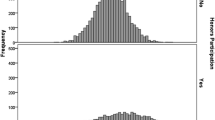Abstract
Students’ choice of college major is related to their interests (Porter and Umbach in Res High Educ 47:429–449, 2006), and students whose major is well-aligned with their interests are more likely to persist in that major (Allen and Robbins in Res Higher Educ 49(1):62–79, 2008) and complete a college degree in a timely manner (Allen and Robbins in J Couns Psychol 51(1):23–35, 2010). This study investigates whether a specific signal (i.e., Low, Medium, or High fit) that high school students receive about the alignment between their initial choice of planned major and their measured interests has an impact on the subsequent certainty of their initial choice of planned major. A regression discontinuity design was used to investigate the stability/increase in planned major certainty across two ACT administrations for students with Medium versus Low fit and High versus Medium fit. Results did not provide evidence that the signal is effective; possible explanations and recommended future research are discussed.





Similar content being viewed by others
Notes
Also included within our study, but not provided in this manuscript, were full-sample OLS regression models that accounted for the linear, quadratic, and cubic functional forms of the forcing variable (i.e., Interest Major Fit correlation). These models were estimated both with and without the additional covariates. The effect of the Interest-Major Fit signal was statistically non-significant across different model specifications.
Results of the full-sample OLS regression models that accounted for the linear, quadratic, and cubic functional forms of the forcing variable (i.e., Interest Major Fit correlation) were consistent with those of the local linear regressions. These results are not provided in the manuscript, but are available upon request.
References
ACT. (2009). ACT interest inventory technical manual. Iowa City, IA: ACT.
ACT. (2013). A Profile of 2013 ACT-Tested High School Graduates: College Choice Report. Part 1: Preferences and Prospects. Iowa City, IA: Author. Retrieved from https://www.act.org/content/dam/act/unsecured/documents/CollegeChoiceRpt-2013-14-Part1.pdf.
ACT. (2014). A Profile of 2013 ACT-Tested High School Graduates: College Choice Report. Part 2: Enrollment Patterns. Iowa City, IA: Author. Retrieved from https://www.act.org/content/dam/act/unsecured/documents/CollegeChoiceRpt-2013-Part2.pdf.
ACT. (2017a). The ACT Technical Manual. Iowa City, IA: Author.
ACT. (2017b). Student Information Booklet. Iowa City, IA: Author.
Allen, J., & Robbins, S. B. (2008). Prediction of college major persistence based on vocational interests, academic preparation, and first-year academic performance. Research in Higher Education,49(1), 62–79.
Allen, J., & Robbins, S. (2010). Effects of interest-major congruence, motivation, and academic performance on timely degree attainment. Journal of Counseling Psychology,51(1), 23–35.
Bloom, H. S. (2012). Modern regression discontinuity analysis. Journal of Research on Educational Effectiveness,5(1), 43–82.
Cruce, T., & Mattern, K. (2015). Sticking to the plan: What factors are related to intended-declared major consistency? Paper presented at the Annual Forum for the Association for Institutional Research. Denver, CO.
EAB. (2016). How late is too late? Myths and facts about the consequences of switching college majors. Washington, D.C.: Author.
Feldman, K. A., Smart, J. C., & Ethington, C. A. (1999). Major field and person-environment fit. The Journal of Higher Education,70(6), 642–669.
Harmston, M., & Crouse, J. (2016). Multiple testers: What do we know about them? ACT Research & Policy Technical Brief. Iowa City, IA: ACT Inc.
Holland, J. L. (1959). A theory of vocational choice. Journal of Counseling Psychology,6(1), 35–45.
Holland, J. L. (1997). Making vocational choices: A theory of vocational personalities and work environments (3rd ed.). Odessa, FL: Psychological Assessment Resources.
Imbens, G. W. & Kalyanaraman, K. (2009). Optimal Bandwidth Choice for the Regression Discontinuity Estimator. National Bureau of Economic Research Working Paper 14726.
Lee, D. S., & Lemieux, T. (2010). Regression discontinuity designs in economics. Journal of Economic Literature,48, 281–355.
Lesik, S. A. (2008). Studying the effectiveness of programs and initiatives in higher education using the regression-discontinuity design. Higher education: Handbook of Theory and Research (pp. 277–297). Dordrecht: Springer.
McCall, B. P., & Bielby, R. M. (2012). Regression discontinuity design: Recent developments and a guide to practice for researchers in higher education. Higher education: Handbook of theory and research (pp. 249–290). Dordrecht: Springer.
National Center for Education Statistics (NCES). (2017). Beginning College Students Who Change Their Majors Within 3 Years of Enrollment. Data Point (NCES 2018-434). Institute of Education Sciences, U.S. Department of Education. Washington, D.C.: Author.
Nye, C. D., Su, R., Rounds, J., & Drasgow, F. (2012). Vocational interests and performance: A quantitative summary of over 60 years of research. Perspectives on Psychological Science,7, 384–403.
Porter, S. R., & Umbach, P. D. (2006). College major choice: An analysis of person-environment fit. Research in Higher Education,47, 429–449.
Rounds, J., & Su, R. (2014). The nature and power of interests. Current Directions in Psychological Science,23, 1–6.
Sklar, J. (2014). The impact of change of major on time to bachelor’s degree completion with special emphasis on STEM disciplines: A multivariate discrete-time hazard modeling approach. Paper presented at the 2014 Forum for the Association for Institutional Research. Orlando, FL.
Su, R. (2012). The power of vocational interests and interest congruence in predicting career success (Unpublished doctoral dissertation). University of Illinois at Urbana-Champaign.
Thistlethwaite, D. L., & Campbell, D. T. (1960). Regression-discontinuity analysis: An alternative to the ex post facto experiment. Journal of Educational Psychology,51(6), 309–317.
Tracey, T. J. G., & Robbins, S. B. (2006). The interest-major congruence and college success relation: A longitudinal study. Journal of Vocational Behavior,69, 64–89.
U.S. Department of Education, Institution of Education Sciences. (2017). What Works Clearinghouse Standards Handbook, Version 4.0, 7/25/2017 Draft. Retrieved from https://ies.ed.gov/ncee/wwc/Docs/ReferenceResources/wwc_standards_handbook_v4_draft.pdf.
Author information
Authors and Affiliations
Corresponding author
Additional information
Publisher's Note
Springer Nature remains neutral with regard to jurisdictional claims in published maps and institutional affiliations.
Rights and permissions
About this article
Cite this article
Moore, J.L., Cruce, T.M. The Impact of an Interest-Major Fit Signal on College Major Certainty. Res High Educ 61, 383–407 (2020). https://doi.org/10.1007/s11162-019-09560-0
Received:
Published:
Issue Date:
DOI: https://doi.org/10.1007/s11162-019-09560-0




